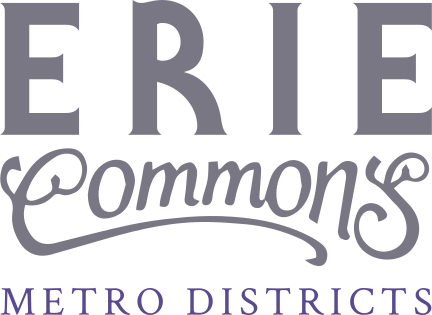About
General Information – Erie Commons Metro District Nos. 1-3
Metropolitan districts are local governments that finance public improvements and provide services to promote the health, safety, prosperity, security, and general welfare of the inhabitants of the districts and the people of the state of Colorado. Metropolitan districts fill the gaps that may exist in services that other local governments will not provide, and the services residents may desire. Collectively, the Eric Commons Metropolitan District Nos. 1-3 (the “Districts”) provide the following improvements and services: storm drainage, streets, traffic and safety controls, parks and recreation, and transportation.
Pursuant to the Consolidated Service Plan for Erie Metropolitan District Nos. 1 & 2, originally approved by Town of Erie on June 20, 2003, as amended (the “District Nos. 1 & 2 Service Plan”), and the Service Plan for Erie Metropolitan District No. 3, originally approved by Town of Erie on September 10, 2019 (the “District No. 3 Service Plan”, and, together with the District Nos. 1 & 2 Service Plan, the “Service Plans”), the Districts are authorized to incur $50,000,000 of aggregate debt in principal and the Districts may each impose a maximum debt mill levy of 50 mills subject to adjustment, as defined in the Service Plans, for repayment of such debt. The Service Plans authorize the repayment of debt from the following sources: ad valorem taxes, fees, rates, tolls, penalties, and charges.
The Boards of Directors (the “Boards”) govern the Districts. Board members are elected for four-year terms. During election years, the Districts must provide the Call for Nominations to the electors of the Districts noting the Board seats up for election. If an owner or resident would like to run for a Board seat up for election, he or she must submit a self-nomination form to the Designated Election Official by the applicable deadline as provided in the Call for Nominations. When a vacancy occurs on the Boards between elections, an owner or resident may contact the Districts and request to submit a letter of interest to be appointed to Boards. When an individual is appointed to the Boards, the term for that appointment runs to the next regular election.
To qualify as a director of a district, a person must be an “eligible elector” which is defined as a registered voter of Colorado and either: (1) a resident of the District, or (2) the owner (or the spouse or civil union partner of the owner) of taxable real or personal property located within the District. A person who is under contract to purchase taxable property and is obligated to pay taxes prior to closing is also considered an “owner.”
The Districts file their annual report for the prior year with the Town of Erie.
A Metro District is a local unit of government formed to provide necessary public services that the county or municipality cannot otherwise provide. It is essentially a tax-exempt financing mechanism used for the installation of public infrastructure. The Metro Districts issue debt to pay for the public infrastructure, which debt is repaid by property taxes levied within the Metro Districts’ boundaries. Public infrastructure includes streets, water, sewer, storm drainage, parks, trails, and other similar improvements.
Initially, growing cities and towns financed and installed public infrastructure serving their municipalities, literally “paving the way” for new homes and businesses. However, cities and towns began to struggle to pay for the public infrastructure needed to grow. In the late 70’s and early 80’s a change to “Growth pays its own way” occurred. This shift by municipalities put the cost burden of growth on the shoulders of future property owners. To facilitate continued growth, the State of Colorado passed reenactment of Title 32 in 1981, the Special District Act, to allow Metropolitan Districts to satisfy the public need for infrastructure and allow the Districts to use tax exempt financing to pay for the public infrastructure. There are now approximately 2,000 Metro Districts operating throughout Colorado and the majority of States across the country having their own versions of the Special District Act using similar structures as Colorado’s special districts.
